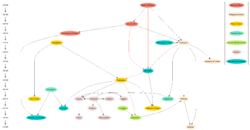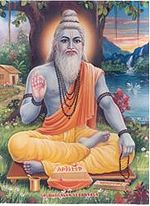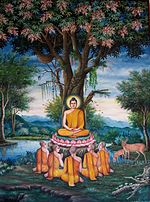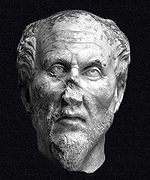- Ancient philosophy
-

History of
Western philosophyWestern philosophy Pre-Socratic · Ancient
Medieval · Renaissance · Modern
Contemporary
16th · 17th · 18th · 19th · 20th CenturySee also Western culture · Western world This page lists some links to ancient philosophy. In Western philosophy, the spread of Christianity through the Roman Empire marked the ending of Hellenistic philosophy and ushered in the beginnings of Medieval philosophy, whereas in Eastern philosophy, the spread of Islam through the Arab Empire marked the end of Old Iranian philosophy and ushered in the beginnings of early Islamic philosophy.
Contents
Ancient Chinese philosophy
Main article: Chinese philosophyChinese philosophy is the dominant philosophical thought in China and other countries within the sinosphere, including Japan, Korea, and Vietnam.
Schools of thought
Hundred Schools of Thought
Main article: Hundred Schools of ThoughtThe Hundred Schools of Thought were philosophers and schools that flourished from 770 to 221 BC, an era of great cultural and intellectual expansion in China. Even though this period - known in its earlier part as the Spring and Autumn period and the Warring States period - in its latter part was fraught with chaos and bloody battles, it is also known as the Golden Age of Chinese philosophy because a broad range of thoughts and ideas were developed and discussed freely. The thoughts and ideas discussed and refined during this period have profoundly influenced lifestyles and social consciousness up to the present day in East Asian countries. The intellectual society of this era was characterized by itinerant scholars, who were often employed by various state rulers as advisers on the methods of government, war, and diplomacy. This period ended with the rise of the Qin Dynasty and the subsequent purge of dissent. The Book of Han lists ten major schools, they are:
- Confucianism, which teaches that human beings are teachable, improvable and perfectible through personal and communal endeavour especially including self-cultivation and self-creation. A main idea of Confucianism is the cultivation of virtue and the development of moral perfection. Confucianism holds that one should give up one's life, if necessary, either passively or actively, for the sake of upholding the cardinal moral values of ren and yi.[1]
- Legalism, which maintained that human nature was incorrigibly selfish; accordingly, the only way to preserve the social order was to impose discipline from above, and to see to a strict enforcement of laws. The Legalists exalted the state above all, seeking its prosperity and martial prowess over the welfare of the common people.
- Taoism, a philosophy which emphasizes the Three Jewels of the Tao: compassion, moderation, and humility, while Taoist thought generally focuses on nature, the relationship between humanity and the cosmos; health and longevity; and wu wei (action through inaction). Harmony with the Universe, or the source thereof (Tao), is the intended result of many Taoist rules and practices.
- Mohism, which advocated the idea of universal love: Mozi believed that "everyone is equal before heaven", and that people should seek to imitate heaven by engaging in the practice of collective love. His epistemology can be regarded as primitive materialist empiricism; he believed that human cognition ought to be based on one's perceptions – one's sensory experiences, such as sight and hearing – instead of imagination or internal logic, elements founded on the human capacity for abstraction. Mozi advocated frugality, condemning the Confucian emphasis on ritual and music, which he denounced as extravagant.
- Naturalism, the School of Naturalists or the Yin-yang school, which synthesized the concepts of yin-yang and the Five Elements; Zou Yan is considered the founder of this school.[2]
- Agrarianism, or the School of Agrarianism, which advocated peasant utopian communalism and egalitarianism.[3] The Agrarians believed that Chinese society should be modeled around that of the early sage king Shen Nong, a folk hero which was portrayed in Chinese literature as "working in the fields, along with everyone else, and consulting with everyone else when any decision had to be reached."[3]
- The Logicians or the School of Names, which focused on definition and logic. It is said to have parallels with that of the Ancient Greek sophists or dialecticians. The most notable Logician was Gongsun Longzi.
- The School of Diplomacy or School of Vertical and Horizontal [Alliances], which focused on practical matters instead of any moral principle, so it stressed political and diplomatic tactics, and debate and lobbying skill. Scholars from this school were good orators, debaters and tacticians.
- The Miscellaneous School, which integrated teachings from different schools; for instance, Lü Buwei found scholars from different schools to write a book called Lüshi Chunqiu cooperatively. This school tried to integrate the merits of various schools and avoid their perceived flaws.
- The School of "Minor-talks", which was not a unique school of thought, but a philosophy constructed of all the thoughts which were discussed by and originated from normal people on the street.
- Another group is the School of the Military that studied strategy and the philosophy of war; Sunzi and Sun Bin were influential leaders. However, this school was not one of the "Ten Schools" defined by Hanshu.
Early Imperial China
The founder of the Qin Dynasty, who implemented Legalism as the official philosophy, quashed Mohist and Confucianist schools. Legalism remained influential until the emperors of the Han Dynasty adopted Daoism and later Confucianism as official doctrine. These latter two became the determining forces of Chinese thought until the introduction of Buddhism.
Confucianism was particularly strong during the Han Dynasty, whose greatest thinker was Dong Zhongshu, who integrated Confucianism with the thoughts of the Zhongshu School and the theory of the Five Elements. He also was a promoter of the New Text school, which considered Confucius as a divine figure and a spiritual ruler of China, who foresaw and started the evolution of the world towards the Universal Peace. In contrast, there was an Old Text school that advocated the use of Confucian works written in ancient language (from this comes the denomination Old Text) that were so much more reliable. In particular, they refuted the assumption of Confucius as a godlike figure and considered him as the greatest sage, but simply a human and mortal
The 3rd and 4th centuries saw the rise of the Xuanxue (mysterious learning), also called Neo-Taoism. The most important philosophers of this movement were Wang Bi, Xiang Xiu and Guo Xiang. The main question of this school was whether Being came before Not-Being (in Chinese, ming and wuming). A peculiar feature of these Taoist thinkers, like the Seven Sages of the Bamboo Grove, was the concept of feng liu (lit. wind and flow), a sort of romantic spirit which encouraged following the natural and instinctive impulse.
Buddhism arrived in China around the 1st century AD, but it was not until the Northern and Southern, Sui and Tang Dynasties that it gained considerable influence and acknowledgement. At the beginning, it was considered a sort of Taoist sect, and there was even a theory about Laozi, founder of Taoism, who went to India and taught his philosophy to Buddha. Mahayana Buddhism was far more successful in China than its rival Hinayana, and both Indian schools and local Chinese sects arose from the 5th century. Two chiefly important monk philosophers were Sengzhao and Daosheng. But probably the most influential and original of these schools was the Chan sect, which had an even stronger impact in Japan as the Zen sect.
Philosophers
- Taoism
- Laozi
- Zhuangzi
- Zhang Daoling
- Zhang Jue
- Ge Hong
- Chen Tuan
- Confucianism
- Legalism
- Mohism
- Mozi
- Song Xing
- Agrarianism
- Xu Xing
- Naturalism
- Neotaoism
- School of Diplomacy
- School of the Military
- Sunzi
- Sun Bin
- Zen
Ancient Greek philosophy
Main article: Ancient Greek philosophy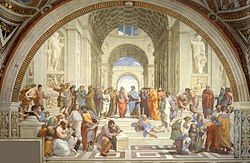 Raphael's School of Athens, depicting an array of ancient Greek philosophers engaged in discussion.
Raphael's School of Athens, depicting an array of ancient Greek philosophers engaged in discussion.
Philosophers
Presocratic philosophers
- Thales (624 BC–ca. 546 BC)
- Anaximander (610-546 BC)
- Anaximenes of Miletus (c. 585-c. 525 BC)
- Pythagoras (582-496 BC)
- Philolaus (470-380 BC)
- Alcmaeon of Croton
- Archytas (428-347 BC)
- Heraclitus (535-475 BC)
- Eleatic School
- Xenophanes (570-470 BC)
- Parmenides (510-440 BC)
- Zeno of Elea (490-430 BC)
- Melissus of Samos (c 470 BC–unknown)
- Empedocles (490-430 BC)
- Anaxagoras (500-428 BC)
- Leucippus (first half of 5th century BC)
- Democritus (460-370 BC)
- Metrodorus of Chios (4th century BC)
- Pherecydes of Syros (6th century BC)
- Protagoras (490-420 BC)
- Gorgias (487-376 BC)
- Antiphon (480-411 BC)
- Prodicus (465/450-after 399 BC)
- Hippias (middle of the 5th century BC)
- Thrasymachus (459-400 BC)
- Callicles
- Critias
- Lycophron
- Diogenes of Apollonia (c. 460 BC-unknown)
Classical Greek philosophers
- Socrates (469-399 BC)
- Euclid of Megara (450-380 BC)
- Antisthenes (445-360 BC)
- Aristippus (435-356 BC)
- Plato (428-347 BC)
- Speusippus (407-339 BC)
- Diogenes of Sinope (400-325 BC)
- Xenocrates (396-314 BC)
- Aristotle (384-322 BC)
- Stilpo (380-300 BC)
- Theophrastus (370-288 BC)
Hellenistic philosophy
- Pyrrho (365-275 BC)
- Epicurus (341-270 BC), see: Epicureanism
- Metrodorus of Lampsacus (the younger) (331–278 BC)
- Zeno of Citium (333-263 BC)
- Cleanthes (331-232 BC)
- Timon (320-230 BC)
- Arcesilaus (316-232 BC)
- Menippus (3rd century BC)
- Archimedes (c. 287-212 BC)
- Chrysippus (280-207 BC)
- Carneades (214-129 BC)
- Clitomachus (187-109 BC)
- Metrodorus of Stratonicea (late 2nd century BC)
- Philo of Larissa (160-80 BC)
- Posidonius (135-51 BC)
- Antiochus of Ascalon (130-68 BC)
- Aenesidemus (1st century BC)
- Philo of Alexandria (30 BC–45 AD)
- Agrippa (1st century AD)
Hellenistic schools of thought
- Cynicism
- Eclecticism
- Epicureanism
- Neo-Platonism
- Peripatetic School
- Skepticism
- Stoicism
- Sophism
Ancient Indian philosophy
Main article: Indian philosophyThe ancient Indian philosophy is a fusion of two ancient traditions : Sramana tradition and Vedic tradition.
Vedic philosophy
Indian philosophy begins with the Vedas where questions related to laws of nature, the origin of the universe and the place of man in it are asked. In the famous Rigvedic Hymn of Creation the poet says:
"Whence all creation had its origin, he, whether he fashioned it or whether he did not, he, who surveys it all from highest heaven, he knows--or maybe even he does not know."
In the Vedic view, creation is ascribed to the self-consciousness of the primeval being (Purusha). This leads to the inquiry into the one being that underlies the diversity of empirical phenomena and the origin of all things. Cosmic order is termed rta and causal law by karma. Nature (prakriti) is taken to have three qualities (sattva, rajas, and tamas).
Sramana Philosophy
Main articles: Jain philosophy, Buddhist philosophy, and SramanaJainism and Buddhism are continuation of the Sramana school of thought. The Sramanas cultivated a pessimistic worldview of the samsara as full of suffering and advocated renunciation and austerities. They laid stress on philosophical concepts like Ahimsa, Karma, Jnana, Samsara and Moksa.
Classical Indian philosophy
In classical times, these inquiries were systematized in six schools of philosophy. Some of the questions asked were:
- What is the ontological nature of consciousness?
- How is cognition itself experienced?
- Is mind (chit) intentional or not?
- Does cognition have its own structure?
The Six schools of Indian philosophy are:
Other traditions of Indian philosophy include:
- Hindu philosophy
- Buddhist philosophy
- Jain philosophy
- Sikh philosophy
- Cārvāka (atheist) philosophy
Buddhism
Timeline: Development and propagation of Buddhist traditions (ca. 450 BCE – ca. 1300 CE)
450 BCE 250 BCE 100 CE 500 CE 700 CE 800 CE 1200 CE India
Early Buddhist schools Mahayana Vajrayana Theravada Buddhism Tibetan Buddhism East Asia
Chán, Tiantai, Pure Land, Zen, Nichiren Shingon
450 BCE 250 BCE 100 CE 500 CE 700 CE 800 CE 1200 CE Legend: = Theravada tradition = Mahayana traditions = Vajrayana traditions Cārvāka
Cārvāka (Sanskrit: चार्वाक), also known as Lokāyata, is a system of Hindu philosophy that assumes various forms of philosophical skepticism and religious indifference.It is named after its founder, Cārvāka, author of the Bārhaspatya-sūtras. In overviews of Hindu philosophy, Cārvāka is classified as a "faithless" (nāstika) system, the same classification as is given to Buddhism and Jainism.It is characterized as a materialistic and atheistic school of thought. While this branch of Indian philosophy is not considered to be part of the six orthodox schools of Hindu philosophy, it is noteworthy as evidence of a materialistic movement within Hinduism. The Cārvāka school of philosophy had a variety of atheistic, materialistic, and naturalistic beliefs. The Carvaka believed there was no afterlife, no life after death
Springing forth from these elements itself solid knowledge is destroyed when they are destroyed— after death no intelligence remains.Naturalism The Carvaka believed in a form of naturalism, that is that all things happen by nature, and come from nature (not from any deity or Supreme Being).
Fire is hot, water cold, refreshingly cool is the breeze of morning; By whom came this variety? They were born of their own nature.Sensual indulgence
Unlike many of the Indian philosophies of the time, the Carvaka believed there was nothing wrong with sensual indulgence, and that it was the only enjoyment to be pursued.
That the pleasure arising to man from contact with sensible objects, is to be relinquished because accompanied by pain— such is the reasoning of fools. The kernels of the paddy, rich with finest white grains, What man, seeking his own true interest, would fling them away because of a covering of husk and dust? While life remains, let a man live happily, let him feed on butter though he runs in debt; When once the body becomes ashes, how can it ever return again?Religion is invented by man
The Carvaka believed that religion was invented and made up by men, having no divine authority.
The three authors of the Vedas were buffoons, knaves, and demons. All the well-known formulae of the pandits, jarphari, turphari, etc. and all the obscene rites for the queen commanded in Aswamedha, these were invented by buffoons, and so all the various kinds of presents to the priests, while the eating of flesh was similarly commanded by night-prowling demons.Ancient Indian philosophers
- Asanga (c. 300), exponent of the Yogacara
- Bhartrihari (c 450–510 AD), early figure in Indic linguistic theory
- Bodhidharma (c. 440–528 AD), founder of the Zen school of Buddhism
- Chanakya (c.350 - c.275 BC), author of Arthashastra, professor (acharya) of political science at the Takshashila University
- Dignāga (c. 500), one of the founders of Buddhist school of Indian logic.
- Gautama Buddha (563 BC - 483 BC), founder of Buddhist school of thought
- Gotama (c. 2nd–3rd century AD), wrote the Nyaya Sutras, considered to be the foundation of the Nyaya school.
- Haribhadra (8th Century CE), a Jaina thinker, author and great proponent of anekāntavāda and classical yoga, as a soteriological system of meditation in Jaina context. His works include Ṣaḍdarśanasamuccaya and Yogabindu.
- Hemacandra (1089–1172 CE) - a Jaina thinker, author, historian, grammarian and logician. His works include Yogaśāstra and Trishashthishalakapurushacharitra.
- Jaimini, author of Purva Mimamsa Sutras
- Kanada (c. 600 BC), founded the philosophical school of Vaisheshika, gave theory of atomism
- Kapila (c. 500 BC), proponent of the Samkhya system of philosophy
- Kundakunda (2nd Century CE), exponent of Jain mysticism and Jain nayas dealing with the nature of the soul and its contamination by matter, author of Pañcāstikāyasāra (Essence of the Five Existents), the Pravacanasāra (Essence of the Scripture) and the Samayasāra (Essence of the Doctrine)
- Lonkā (15th century CE) – His opposition to idol worship and rituals eventually led to establishment of non-iconic sects of Sthanakvasi and Terapanthi.
- Nagarjuna (c. 150 - 250 AD), the founder of the Madhyamaka (Middle Path) school of Mahāyāna Buddhism.
- Pāṇini (520–460 BC), grammarian, author of Ashtadhyayi
- Patañjali (between 200 BC and 400 AD), developed the philosophy of Raja Yoga in his Yoga Sutras.
- Pingala (c. 500 BC), author of the Chandas shastra
- Adi Shankara (788-820 AD), the first philosopher to consolidate the doctrine of Advaita Vedanta, a sub-school of Vedanta
- Siddhasena Divākara (5th Century CE), Jain logician and author of important works in Sanskrit and Prakrit, such as, Nyāyāvatāra (on Logic) and Sanmatisūtra (dealing with the seven Jaina standpoints, knowledge and the objects of knowledge)
- Syntipas (c. 100 BC), author of The Story of the Seven Wise Masters.
- Tiruvalluvar (between 100 BC and 300 AD), author of Thirukkural, one of the greatest ethical works in Tamil language
- Umāsvāti or Umasvami (2nd Century CE), author of first Jain work in Sanskrit, Tattvārthasūtra, expounding the Jain philosophy in a most systematized form acceptable to all sects of Jainism.
- Vasubandhu (c. 300 AD), one of the main founders of the Indian Yogacara school.
- Vyasa (c. 3000 BC), author of several important works in Hindu philosophy
- Yajnavalkya (Prehistoric), linked to philosophical teachings of the Brhadaranyaka Upanishad, and the apophatic teaching of 'neti neti' etc.
- Yaśovijaya Gaṇi (1624–88 CE) – Jain logician and considered last intellectual giant to contribute to Jaina philosophy.
Ancient Iranian philosophy
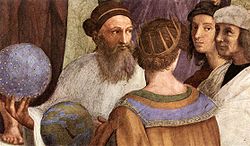 Zarathustra as depicted in Raffael's The School of Athens beside Raffael who appears as the ancient painter Apelles of Kos (Ἀπελλῆς).
Zarathustra as depicted in Raffael's The School of Athens beside Raffael who appears as the ancient painter Apelles of Kos (Ἀπελλῆς). Main article: Iranian philosophy
Main article: Iranian philosophySee also: Dualism, Dualism (philosophy of mind)
While there are ancient relations between the Indian Vedas and the Iranian Avesta, the two main families of the Indo-Iranian philosophical traditions were characterized by fundamental differences in their implications for the human being's position in society and their view on the role of man in the universe. The first charter of human rights by Cyrus the Great as understood in the Cyrus cylinder is often seen as a reflection of the questions and thoughts expressed by Zarathustra and developed in Zoroastrian schools of thought of the Achaemenid Era of Iranian history.[4][5]
Schools of thought
- Zoroastrianism
- Mazdakism
- Manichaeism
- Zurvanism
- Other ancient philosophers
Philosophy and the Empire
- Political Philosophy
- University of Gundishapur
- Emperor Khosrau's philosophical discourses
Literature
- Pahlavi literature
Continuation in Iranian philosophy
- Persian Illuminationism
- School of Isfahan
- Transcendent Philosophy
- Sadr Shirazi
In Western literature and culture
In addition to many remarkable reflections in Ancient and Medieval European literature, such as those related to Zoroastrian and Manichaean ideas and challenges, in recent Western literature Iranian philosophy appears and is treated in various ways. Two eminent examples are:
- Thus Spoke Zarathustra by the German philosopher Friedrich Nietzsche
- Creation by the American thinker Gore Vidal
Early Roman and Christian philosophy
See also: Jewish philosophy, Christian philosophy
Philosophers during Roman times
- Cicero (106-43 BC)
- Lucretius (94-55 BC)
- Seneca (4 BC–65 AD)
- Paul of Tarsus (c. 6BC-c. 67AD)
- Musonius Rufus (30 AD–100 AD)
- Plutarch (45-120 AD)
- Epictetus (55-135 AD)
- Marcus Aurelius (121-180 AD)
- Clement of Alexandria (150-215 AD)
- Alcinous (philosopher) (2nd century AD)
- Sextus Empiricus (3rd century AD)
- Alexander of Aphrodisias (3rd century AD)
- Ammonius Saccas (3rd century AD)
- Plotinus (205-270 AD)
- Porphyry (232-304 AD)
- Iamblichus (242-327 AD)
- Themistius (317-388 AD)
- Augustine of Hippo (354-430 AD)
- Proclus (411-485 AD)
- Philoponus of Alexandria (490-570 AD)
- Damascius (462-540 AD)
- Boethius (472-524 AD)
- Simplicius of Cilicia (490-560 AD)
References
- ^ Lo, Ping-cheung (1999), Confucian Ethic of Death with Dignity and Its Contemporary Relevance, Society of Christian Ethics, http://arts.hkbu.edu.hk/~pclo/e5.pdf
- ^ "Zou Yan". Encyclopædia Britannica. http://www.britannica.com/EBchecked/topic/607826/Zou-Yan. Retrieved 1 March 2011.
- ^ a b Deutsch, Eliot; Ronald Bontekoei (1999). A companion to world philosophies. Wiley Blackwell. p. 183.
- ^ Philip G. Kreyenbroek: "Morals and Society in Zoroastrian Philosophy" in "Persian Philosophy". Companion Encyclopedia of Asian Philosophy: Brian Carr and Indira Mahalingam. Routledge, 2009.
- ^ Mary Boyce: "The Origins of Zoroastrian Philosophy" in "Persian Philosophy". Companion Encyclopedia of Asian Philosophy: Brian Carr and Indira Mahalingam. Routledge, 2009.
External links
Categories:- Ancient philosophy
- History of philosophy
- Philosophy by era
Wikimedia Foundation. 2010.

